Call for more Millennials and Gen Zs to give blood as NHS reveals most donors are over 45
 The NHS is calling for more younger donors to give blood as it is revealed that for the first time in five years there are more donors over the age of 45 than under.
The NHS is calling for more younger donors to give blood as it is revealed that for the first time in five years there are more donors over the age of 45 than under.
Older people now make up 51 percent of regular donors (1), overtaking 17-44-year-olds who had been in the majority since 2018.
Meanwhile, the proportion of the youngest donors has shrunk, with only half as many 17-24-year-olds giving blood now compared with five years ago (2).
NHS Blood and Transplant has revealed the statistics as it calls for more younger people to become lifesavers in 2024 in the latest phase of its Giving Types campaign.
It is calling on 17 to 35-year-olds to make a 'no sweat, feel good' start to the year - giving blood - that will easily slot into their lives alongside even the most committed exercise regime.
That made my Christmas
Tami Aderonmu, a 19-year-old student from Essex, donated for the first time just before Christmas at Bristol Donor Centre.
 Tami, who is studying physics and philosophy at the University of Bristol and lives in the city, said:
Tami, who is studying physics and philosophy at the University of Bristol and lives in the city, said:
"Needles don’t really bother me but I still expected it to be scary. But it was the opposite.
"The staff are amazing and go the extra mile to put you at your ease when they know it’s your first time. And all the other donors looked like they were having the best day. It was good vibes all round.
"The process is straightforward. You answer a few questions, have the iron test and then sit back while you donate. It doesn't hurt. It’s actually quite relaxing. And you get free snacks!"
She added: "I'm a donor for life now. To anyone who is unsure, I would say go for it, there really is nothing to worry about. And just think about who you may be helping. It's a small act but one that can make a big difference to someone’s life."
Tami’s donation was organised with ACSGiveBlood, an organisation which encourages students to become donors, particularly those of Black heritage whose donations are urgently needed to help sickle cell patients.
Tami added: "After my donation I found out I have the blood type that sickle cell patients need. That made my Christmas! My mum is a doctor and has told me how important ethnically matched blood is for treating sickle cell. Sadly, she has lost family members to sickle cell. So it feels special to me that my blood can help others with the condition.”
The proportion of older donors has steadily increased over recent years (3). Currently around 408,000 of the 798,000 people who regularly give blood are 45 or over. Older donors are now in the majority in every region of England except for London.
Dr Jo Farrar, Chief Executive of NHS Blood and Transplant, said:
"Because lifesaving blood only has a short shelf life, we need to constantly collect it and need a steady stream of new donors.
"For the first time in five years, we have more donors who are aged over 45 than under, so it has never been more important for younger people to become lifesavers by giving blood.
"Giving blood feels great. In just one hour you can save up to three lives. Please register and book your first appointment today."
How you can support us
NHS Blood and Transplant’s Giving Types campaign encourages people who give in big and little ways – such as giving up a seat on a train or raising money for charity - to consider becoming a blood donor.
The campaign particularly aims to recruit more donors of Black heritage as they are more likely to have the blood type urgently needed to treat people with sickle cell, the fastest growing genetic blood disorder in the UK.
Register as a blood donor and book your first appointment via the GiveBloodNHS app or through our website. If you can’t find an appointment straight away please book for further in the future. Your blood will still help to save lives then.
Press release notes
- In the year to end April 2023. A regular donor is an existing donor who has donated at least once in the previous 12 months.
- 17-24-year-olds made up 7.2 percent of the donor base in 2022/23 and 13.07 percent in 2017/18.
- Proportion of older donors aged 45 and over during the last five years: 2018/19: 48.7 percent; 2019/20: 49 percent; 2020/21: 49.4 percent; 2021/22: 49.9 percent; 2022/23 51.1 percent.
